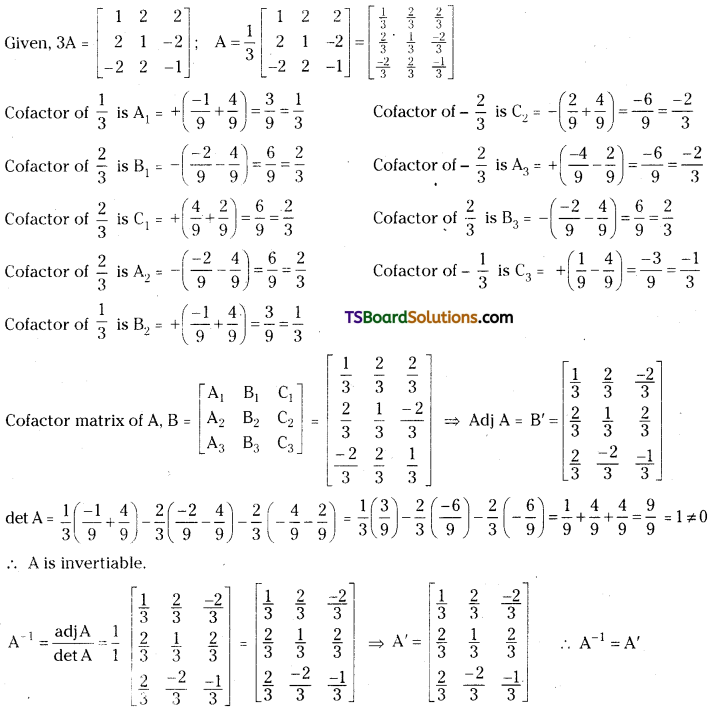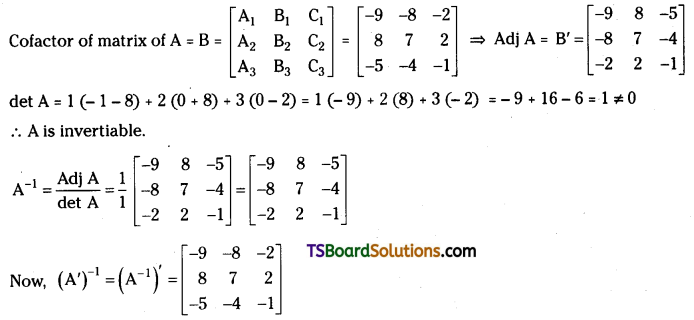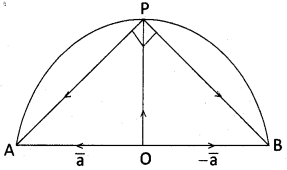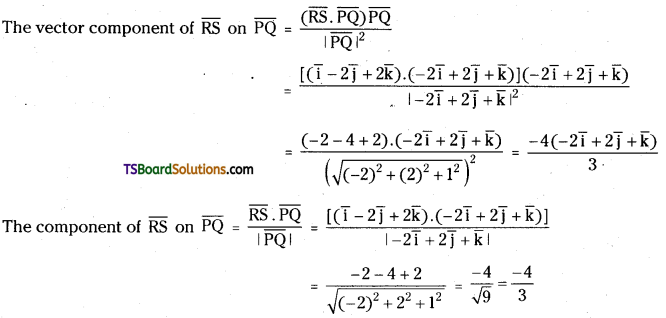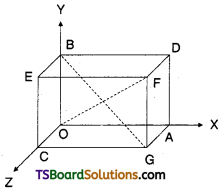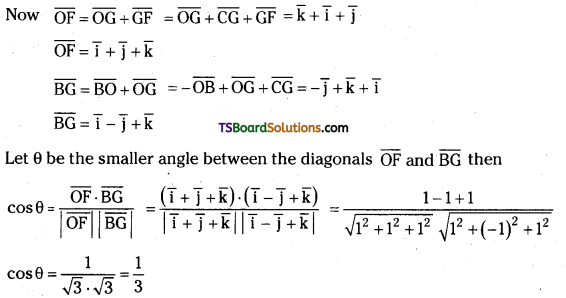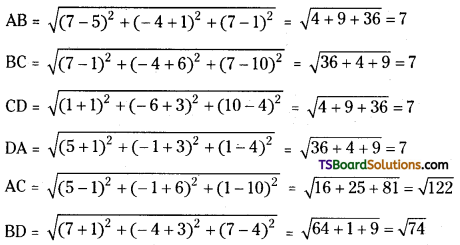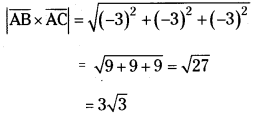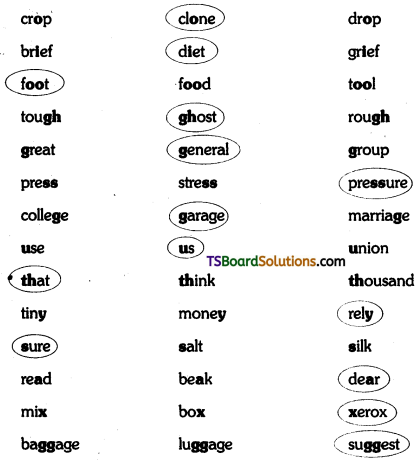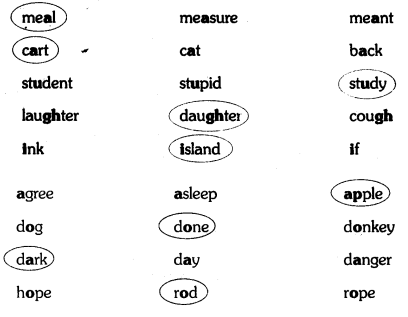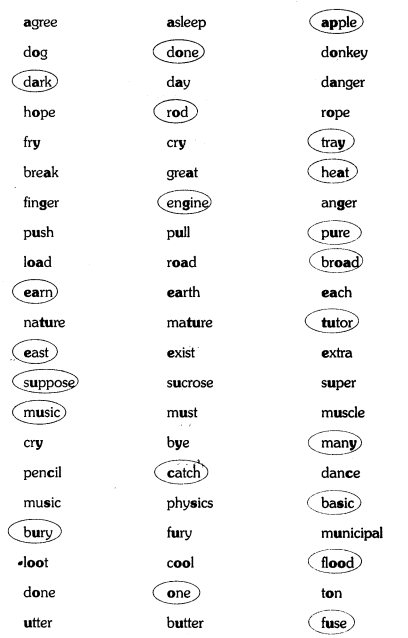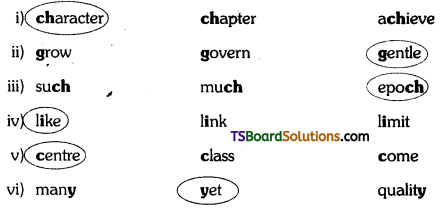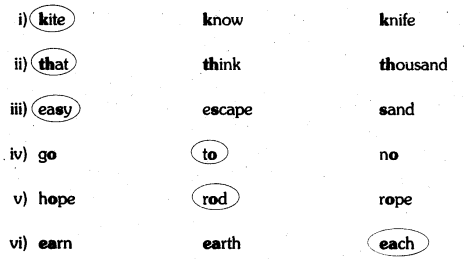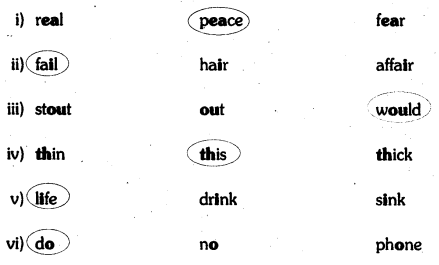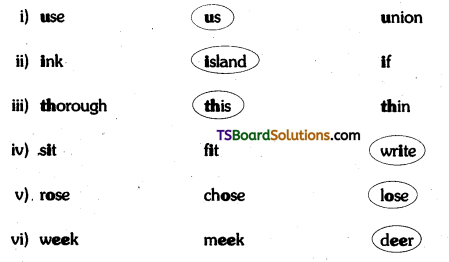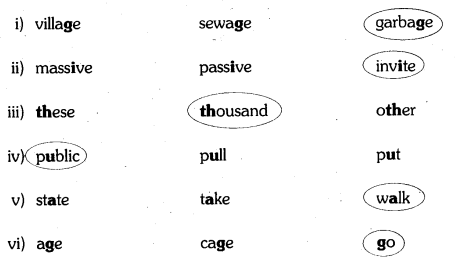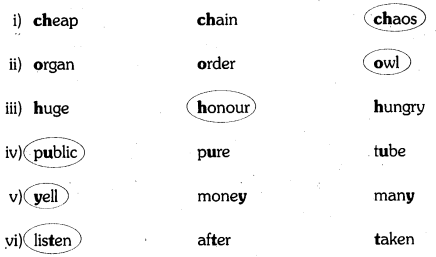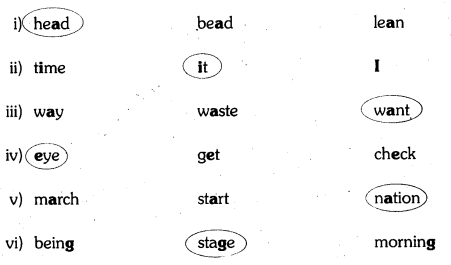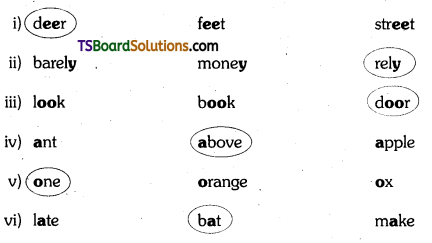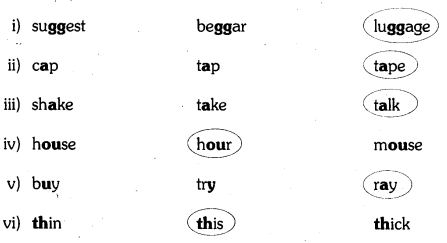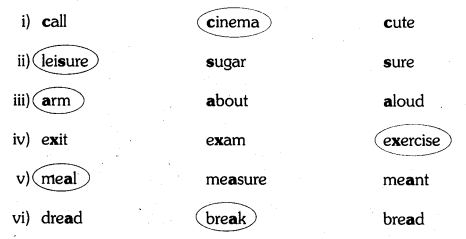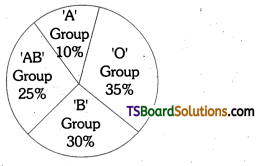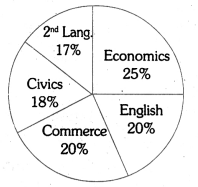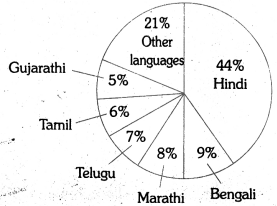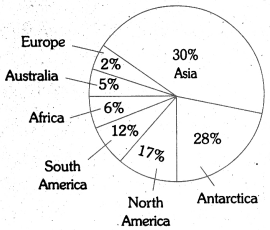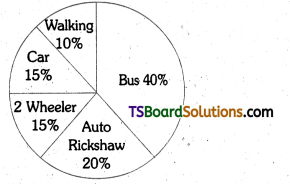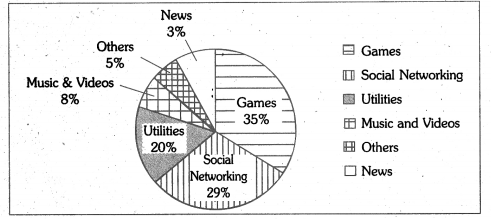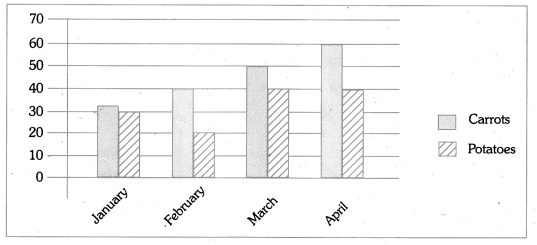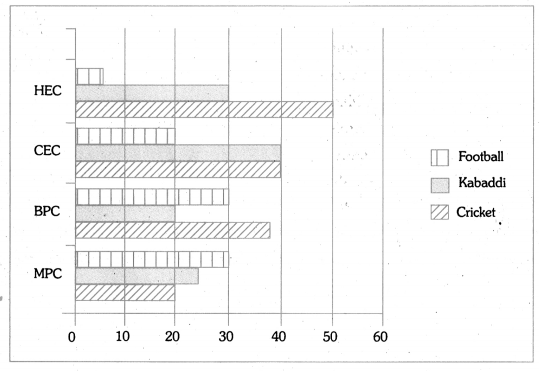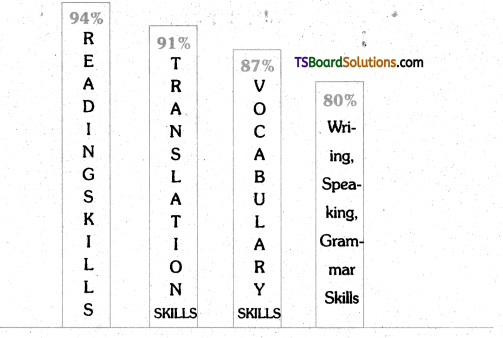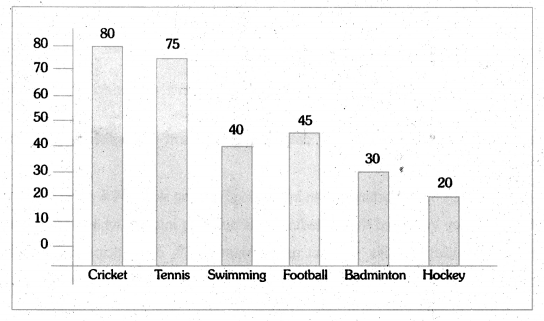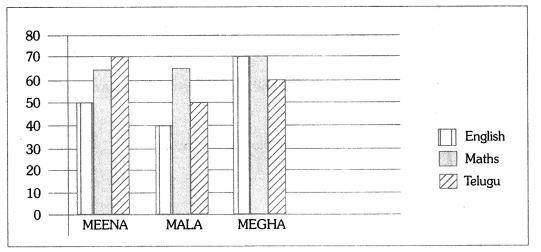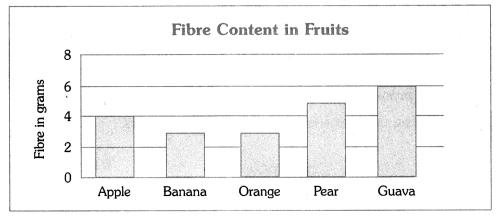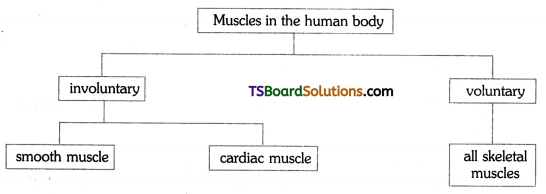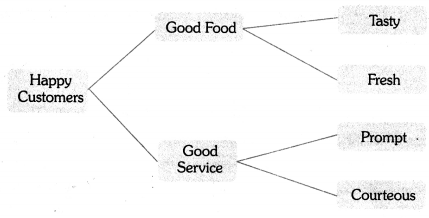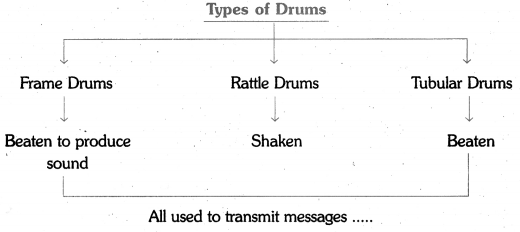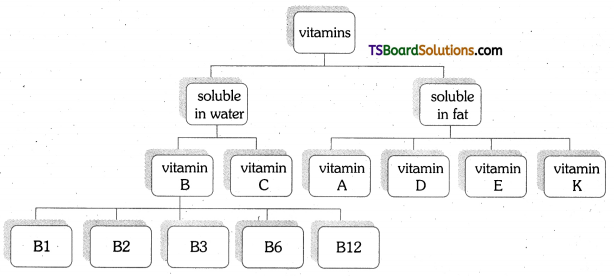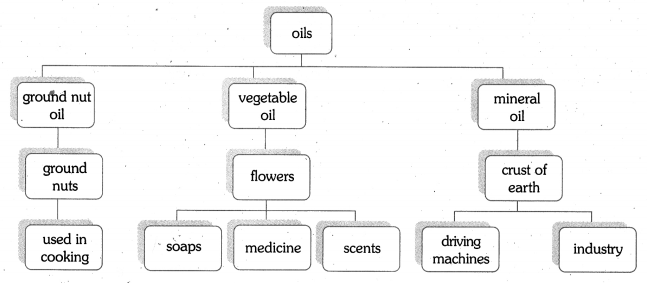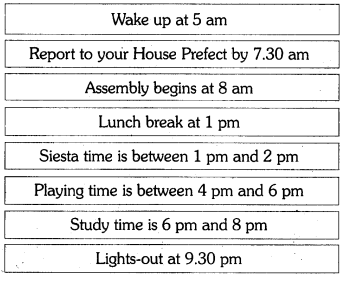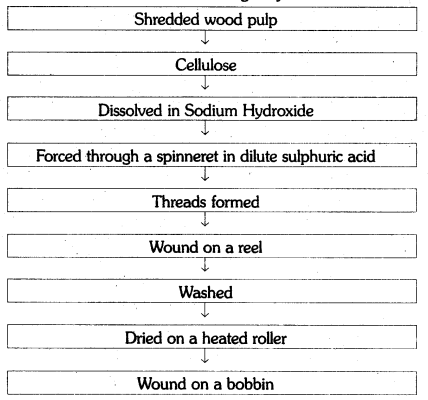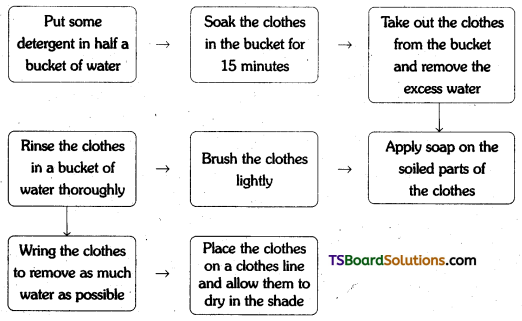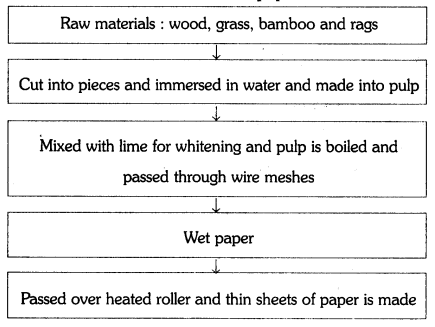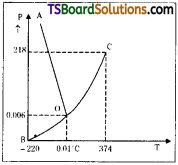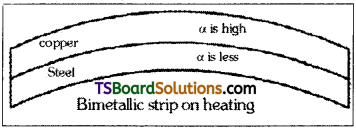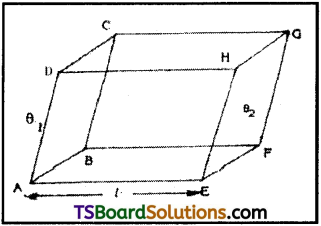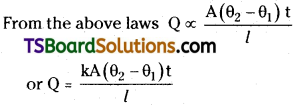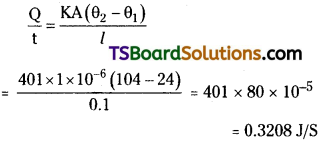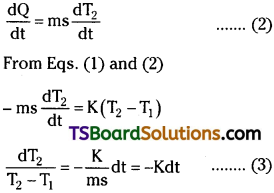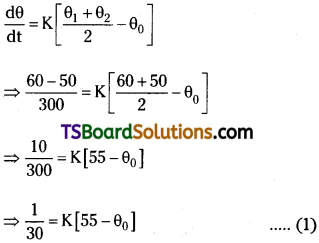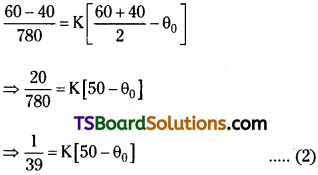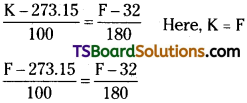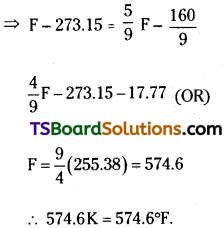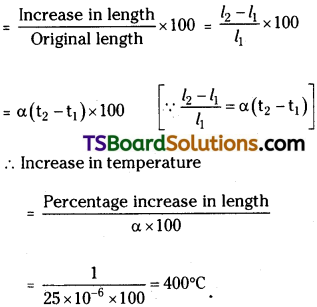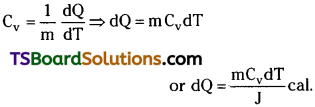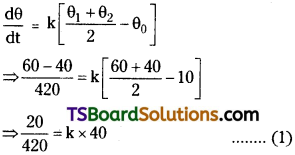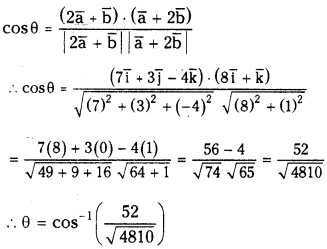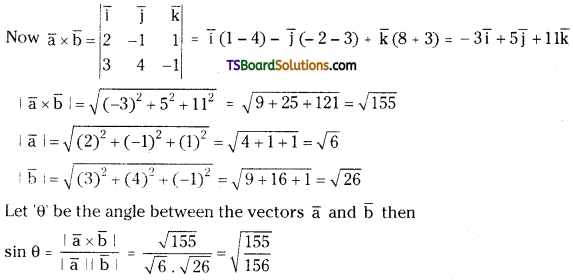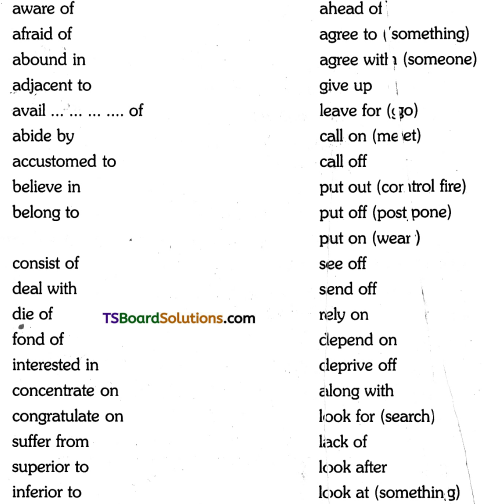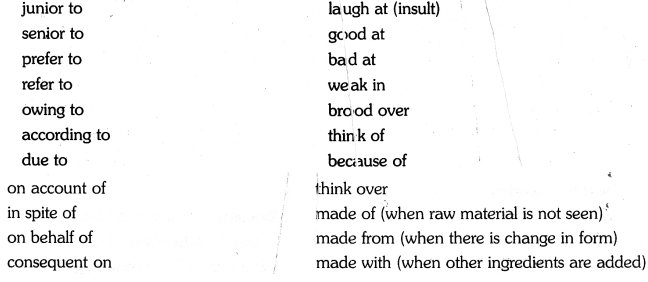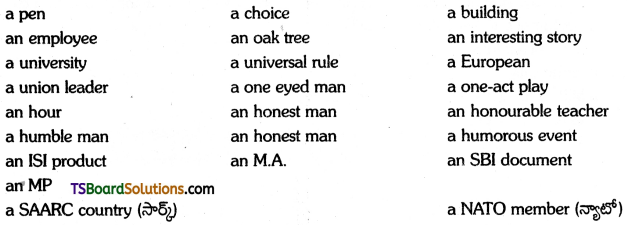Telangana TSBIE TS Inter 1st Year Physics Study Material 11th Lesson Mechanical Properties of Fluids Textbook Questions and Answers.
TS Inter 1st Year Physics Study Material 11th Lesson Mechanical Properties of Fluids
Very Short Answer Type Questions
Question 1.
Define average pressure. Mention it’s unit and dimensional formula. Is it a scalar or a vector? [AP Mar. ’17]
Answer:
Average pressure (Pav) :
The normal force acting per unit is called average pressure.
⇒ Pav = \(\frac{F}{A}\)
Units : In SI = Nm-1
The dimensional formula : ML-1T-2
It is a scalar quantity.
Question 2.
Define Viscosity. What are its units and dimensions? [AP May ’16, ’13; TS May ’18, June ’15)
Answer:
Viscosity :
The property of a fluid which opposes the relative motion between the layers is called viscosity.
Units in SI:
Coefficient of viscosity Nm-2 s (or) Pa – s. (or) Poiseuille
Units in C.G.S : Coefficient of viscosity = poise.
The dimensional formula = ML-1 T-1.
Question 3.
What is the principle behind the carburetor of an automobile? [TS Mar. ’18, ’17; AP Mar. ’19, ’15; June ’15]
Answer:
Carburetor of an automobile is based on the principle of “Bernoulli’s theorem”.
Question 4.
What is magnus effect? [AP May ’18, ’17, Mar. ’15; TS Mar. ’19, ’16]
Answer:
Magnus effect :
When a spinning ball is thrown it deviates from its usual path in flight. This effect is called Magnus effect.
Question 5.
Why are drops and bubbles spherical? [AP Mar. ’18, ’17, ’16, ’14, May ’18, ’17, ’16, ’14, ’13; TS May ’18, ’17, ’16]
Answer:
Due to property of surface tension, the surface of liquid behaves like a stretched membrane and has a tendency to acquire minimum surface area. The sphere has minimum surface area when compared to other shapes of same volume.
Therefore, drops and bubbles acquire spherical shape in order to have the minimum surface area.

Question 6.
Give the expression for the excess pressure in a liquid drop. [TS Mar. ’17]
Answer:
Excess of pressure in a liquid drop is,
p = \(\frac{2s}{r}\) where ‘s’ = surface tension and ‘r’ = the radius of the liquid drop.
Question 7.
Give the expression for the «<cess pressure in an air bubble inside the iquid. [AP Mar. ’19]
Answer:
Excess of pressure in an air buble inside the liquid is, P = \(\frac{2S}{R}\)
where S = Surface Tension, R = Radius of air bubble of liquid.
Question 8.
Give the expression for the excess pressure in a soap bubble in air. [TS Mar. ’16]
Answer:
Excess of pressure in a soap bubble is, p = \(\frac{4s}{r}\) where
‘s’ = surface tension and
‘r’ = radius of the drop.
Question 9.
What are water proofing agents and water wetting agents? What do they do?
Answer:
Water proofing agents :
The substances which are used to increase the angle of contact are called “water proofing agents”.
Wetting agents:
The substances which are used to decrease the angle of contact are called “wetting agents”.
Ex: Soaps, detergents and dying substances.
Question 10.
Why water droplets wet the glass surface and does not wet lotus leaf? [TS Mar. ’15]
Answer:
Angle of contact between water drop and glass is less than 90° so water drop will wet glass surface.
Angle of contact between water and lotus leaf is greater than 90°. So water drops cannot wet lotus leaf.
Question 11.
What is angle of contact? [AP May ’14, Mar. 16]
Answer:
Angle of contact: It is the angle between the walls of the container and the tangent drawn over the surface of the liquid. This angle must be. measured in the interior side of the liquid.

Question 12.
Mention any two examples (or) applications that Obey Bernoullis theorem and justify them. [AP Mar. ‘ 18; TS Mar. 15]
Answer:
Applications of Bernoulli’s theorem :
- Dynamic lift on the wings of an aeroplane
- Swinging of a spinning cricket ball is a consequence of Bernoulli’s theorem.
- During cyclones, the roof of thatched houses will fly away. This is a consequence of Bernoulli’s theorem.
Question 13.
When water flows through a pipe, which of the layers moves fastest and slowest? [TS June ’15]
Answer:
When water is flowing through a pipe water layers in contact with bottom layers of pipe will have lowest velocity and water layer just below the top of inner layer of pipe will have highest velocity.
Question 14.
“Terminal velocity is more if surface area of the body is more.” Give reasons in support of your answer.
Answer:
Yes, Terminal velocity of a body is more when surface area of a body is more.
According to Stokes formula, terminal velocity of a smooth spherical body is,

The surface area of a spherical body A = 4πr². So when surface increases, ‘r²’ value increases. Hence from Stoke’s formula, Teminal velocity increases.
Short Answer Questions
Question 1.
What is atmospheric pressure and how is it determined using Barometer?
Answer:
The atmospheric pressure at any point is equal to the weight of a vertical column of air of unit cross-sectional area extending from that point to the top of tfie earth’s atmosphere.
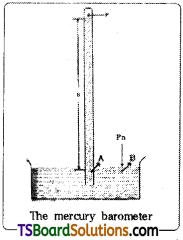
Determination of atmospheric pressure using Barometer :
A long tube closed at one end and filled with mercury is inverted into a trough of mercury. This device is known as mercury barometer. The space above the mercury column in the tube contains only mercury vapour whose pressure p is so small that it may be neglected. Otherwise there is a perfect vacuum, which is called Torricellian vacuum.
The pressure inside the column at point A must equal the pressure at point B, which is at the same level.
‘P’ at A = Pressure at B = atmospheric pressure = Pa
Pa = ρgh …………. (1)
where ρ = density of mercury
h = height of mercury column
In this experiment, it is found that the mercury column in the barometer has a height of about 76 cm at sea level equivalent to one atmosphere (1 atm).
At sea level, atmospheric pressure is the pressure exerted by 0.76 m of mercury column, i.e., h = 0.76 m
ρ = 13.6 × 10³ kg m-3 And g = 9.8 ms-2.
∴ Atmospheric pressure, Pa = hρg
= 0.76 × (13.6 × 10³) × 9.8
= 1.013 × 105 Nn-2 (or) Pa
A common way of stating pressure is in terms of cm or mm of mercury (Hg). A pressure equivalent to 1 mm is called a torr.
1 torr = 133 Pa.

Question 2.
State Dalton’s law of partial pressures. [AP Mar. ’14]
Answer:
Dalton’s law of partial pressures :
For a mixture of non interacting ideal gases at same temperature and volume total pressure in the vessel is the sum of partial pressures of individual gases.
i.e. P = P1 + P2 + ……….. total pressure
P1, P2, ……… etc. are individual pressures of each gas.
Question 3.
What is gauge pressure and how is a manometer used for measuring pressure differences?
Answer:
Gauge Pressure :
The pressure p, at depth below the surface of a liquid open to the atmosphere is greater than atmospheric pressure by an amount ρgh. The excess pressure (P – Pa), at depth h is called as “gauge pressure at that point.”
Measurement of pressure difference using a Manometer :
An open tube manometer is a useful instrument for measuring pressure differences. It consists of a U-tube containing a suitable liquid i.e., a low density liquid (such as oil) for measuring small pressure differences and high density liquid (such as mercury) for large pressure differences. One end of the tube is open to the atmosphere and other end is connected to the system whose pressure to be measured.
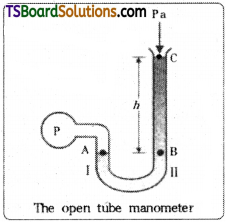
The pressure P at A is equal to pressure at point B. If the pressure in the vessel is more than the earth’s atmospheric pressure, then the level of liquid in arm-I of U-tube will go down upto point A and the level of liquid in arm-II of U-tube will rise up to point C. Then the pressure of air in vessel is equal to pressure at point A. Let ‘h’ be the difference of liquid levels in the two arms of U-tube. Let ρ be the density of liquid in U-tube and Pa be the atmospheric pressure.
Since, the pressure is same at all points, at the same level, so pressure at point A,
PA = pressure at point B
= pressure at C + pressure due to column of liquid of height ‘h’.
So, PA = PC + hρg or PA – PC = hρg ………… (1)
Here, PC = Pa = atmospheric pressure.
If PA = P, then from eq ………. (1)
P – Pa = hρg
Here, P – Pa = Pg = gauge pressure = hρg.
Question 4.
State Pascal’s law and verify it with the help of an experiment.
Answer:
Pascal’s law:
It states that “the pressure in a fluid at rest is the same at all points if they are at the same height”.
Proof of Pascal’s law:
Consider an element in the interior of a fluid at rest as shown in the figure. The element ABC – DEF is in the form of a right-angled prism.
In principle, this prismatic element is very small so that every part of it can be considered at the same depth from the liquid surface and therefore, the effect of gravity is the same at all these points.
The forces on this element are those exerted by the rest of the fluid and they must be normal to the surfaces of the element.
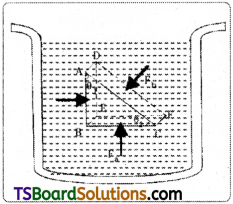
Thus, the fluid exerts pressures Pa, Pb and Pc on this element of area corresponding to the normal forces Fa, Fb and Fc as shown in fig. on the faces BEFC, ADFC and ADEB denoted by Aa, Ab and Ac respectively. Then,
Fb sin θ2 = Fc and Fb cos θ2 = Fa (by equilibrium)
Ab sin θ2 = Ac and Ab cos θ2 = Aa (by geometry)
Thus, \(\frac{F_b}{A_b}=\frac{F_c}{A_c}=\frac{F_a}{A_a}\) ⇒ Pb = Pc = Pa
Hence, pressure exerted is same in all directions in a fluid at rest.
This proves the Pascal’s law.
Question 5.
Explain hydraulic lift and hydraulic brakes.
Answer:
Hydraulic lift and Hydraulic brakes are based on the Pascal’s law. The principle states that “whenever external pressure is applied on any part of a fluid contained in a vessel, it is transmitted undiminished and equally in all directions
Hydralic lift:
In a hydraulic lift, two pistons are separated by the space filled with a liquid as shown in fig.
A piston of small cross-section A1 is used to exert a force F, directly on the liquid.
The pressure, P = \(\frac{F_1}{A_1}\) is transmitted throughout the liquid to the larger cylinder attached with a larger piston of area A2, which results in an upward force of P × A2.
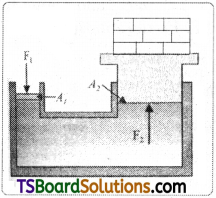
Therefore, the piston is capable of supporting large force.
F2 = PA2 = \(\frac{F_1A_2}{A_1}\)
By changing the force at A1, the platform can be moved up or down. Thus, the applied force has been increased by a factor of \(\frac{A_2}{A_1}\) and this factor is the mechanical advantage of the device.
Hydraulic brakes :
Hydraulic brakes in automobiles also work on Pascal’s principle. When we apply a little force on the pedal with our foot, the master piston moves inside the master cylinder, and the pressure caused is transmitted through the brake oil to act on a piston of larger area. A large force acts on the piston and is pushed down expanding the brake shoes against brake lining. In this way, a small force on the pedal produces a large retarding force on the wheel.
An important advantage of the system is that the pressure set up by pressing pedal is transmitted equally to all cylinders attached to the four wheels so that the braking effort is equal on all wheels.

Question 6.
What is hydrostatic paradox?
Answer:
Hydrostatic paradox :
This is useful to prove that the liquid pressure is the same at all points at the same horizontal level.
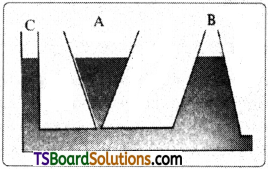
Consider three vessels A, B and C of different shapes as shown in the figure. They are connected at the bottom by a horizontal pipe. On filling with water, the level in the three vessels is the same though they hold different amounts of water. This is so, because water at the bottom has the same pressure below each section of the vessel.
Thus, it proves that the height of the fluid column is independent of the cross sectional or base area and the shape of the container
Question 7.
Explain how pressure varies with depth.
Answer:
Variation of pressure with depth:
Consider a fluid at rest in a container. Let point 1 is at a height h’ above a point 2 as shown in the figure. Consider a cylindrical element of fluid having area of base ‘A’ and height ‘h’. As the fluid is at rest, the resultant horizontal forces should be zero and the resultant vertical forces should balance the weight of the element. The forces acting in the vertical direction are due to the fluid pressure at the top (P1A) acting downward, at the bottom (P2A) acting upward.
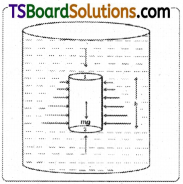
If ‘mg’ is weight of the fluid in the cylinder, we have
(P2 – P1) A = mg …………. (1)
Now, if ρ is the mass density of the fluid, then mass of fluid, m = ρv
⇒ m = ρhA …………. (2)
∴ From (1) and (2)
P2 – P1 = ρgh …………. (3)
Pressure difference depends on the vertical distance ‘h’ between the points (1 and 2), mass density of the fluid p and acceleration due to gravity ‘g’.
If the point 1 under discussion is shifted to the top of the fluid, which is open to the atmosphere, P1 may be replaced by atmospheric pressure (Pa) and we replace P2 by P2 then eq.(2) becomes
P – Pa = ρgh ⇒ P = Pa + ρgh
Thus, the pressure P, at depth below the surface of a liquid open to the atmosphere is greater than atmospheric pressure by an amount ρgh.
Question 8.
What is Torricelli’s law? Explain how the speed of efflux is determined with an experiment.
Answer:
Torricelli’s law :
Torricelli discovered that the speed of efflux from an open tank is given by a formula identical to that of a freely falling body. The word efflux means ‘fluid outflow’.
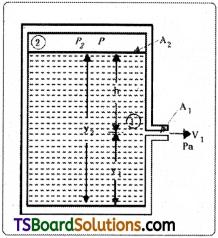
Determination of speed of Efflux:
Consider a tank containing a liquid of density ‘ρ’ with a small hole at a height ‘y1‘, from the bottom as shown in the figure.
The air above the liquid, whose surface is at height ‘y2‘, is at pressure, P.
From the equation of continuity, we have
V1 A1 = V2A2 ⇒ V2 = \(\frac{A_1}{A_2}\)V1 …….. (1)
It the cross sectional area of the tank, A2 is much larger than that of the hole (i.e., A2 >> A1), then we may consider the fluid to be approximately at rest at the top. i.e., V2 = o.
Now, applying the Bernoulli equation at points (1) and (2) and noting that, at the hole P1 = Pa, the atmospheric pressure, we get.
Pa + \(\frac{1}{2}\)ρv²1 + ρgy1 = P + ρgy2
Taking y2 – y1 = h, we have

When P > > Pa and 2gh may be ignored, the speed of efflux is determined by the container pressure. Such a situation occurs in rocket propulsion. On the other hand if the tank is open to the atmosphere, then P = Pa and from eq (2), we get
V1 = \(\sqrt{2gh}\) ………….. (3)
This is the speed of a freely falling body, at any point of height ‘h’ during its fall. This equation is known as “Torricelli’s law”.
Question 9.
What is Venturimeter? Explain how it is used.
Answer:
Venturi-meter :
The venturi meter is a device to measure the flow speed of incompressible fluid.
It consists of a tube with a broad diameter and a small constriction at the middle as shown in the figure.
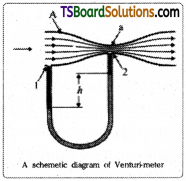
The manometer contains a liquid of density ρm. The speed ν1 of the liquid flowing through the tube at the broad neck area A is to be measured. From equation of continuity, the speed at the constriction, ν2 = \(\frac{A}{a}\) ν1
According to Bernoulli’s equation,
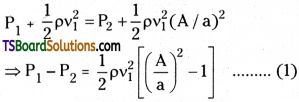
This pressure difference causes the fluid in the U-tube connected at the narrow neck to rise in comparison to the other arm.
The difference in height h measures the pressure difference.
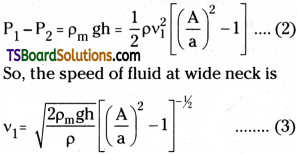
Uses: Venturi meter is used for measuring the speed of incompressible liquid and rate of flow of liquid through pipes.

Question 10.
What is Reynold’s number? What is its significance?
Answer:
Reynold’s number Re :
Reynold’s number is a pure number which determines the nature of flow of liquid through a pipe.
Re = \(\frac{\rho v d}{\eta}\)
where
η = coefficient of viscosity of the liquid.
ρ = density of liquid
ν = critical velocity of the liquid flowing through the pipe.
d = diameter of the pipe.
Significance :
Re is dimensionless number and therefore, it remains same in any system of units.
The critical Reynold’s number for the onset of turbulence is in the range 1000 to 10000, depending on the geometry of the flow. For most cases
Re < 1000 signifies laminar flow.
1000 < Re < 2000 is unsteady flow.
Re < 2000 implies turbulent flow.
Reynold’s number describes the ratio of the inertial force per unit area to the viscous force per unit area for a flowing fluid.
Question 11.
Explain dynamic lift with examples.
Answer:
Dynamic lift on a spinning ball :
Consider the motion of a spinning ball. Its motion consists of two parts 1) Translatory motion 2) Self rotation called spinning.
1) Translatory motion:
Due to translatory motion it passes through the medium air with a velocity say (V). Due to translatory motion the number of streamlines on the top of the ball and at the bottom of the ball are equal. So there is no resultant force on the ball due to translatory motion through the fluid. Hence dynamic lift is zero.
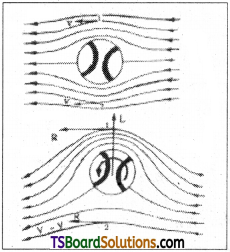
2) For spinning motion :
Let the ball rotates about its axis with a velocity say ∆V in clockwise direction since surface of ball is not perfectly smooth it will drag air molecules with it. So at the top layers the velocity of air is V + ∆V due to air drag. At bottom layers the velocity of air is V – ∆V.
As velocity is more at top layers pressure is less and velocity is less at bottom layers, so pressure is high at bottom layers. This is due to Bernoulli’s theorem.
Due to the pressure difference at bottom layers and top layers some upward thrust will act on the ball. So some dynamic lift will act on a spinning ball. As a result the path of a spinning ball is curved.
Question 12.
Explain Surface Tension and Surface energy. [AP Mar. ’13]
Answer:
Surface tension the force per unit length on an imaginary line drawn on the surface of the liquid and acting perpendicular to it.

Surface energy:
The work done to increase the surface area of a liquid is called surface energy.
Surface energy = Surface tension × Increase in surface area.
Question 13.
Explain how surface tension can be measured experimentally.
Answer:
To find surface tension of a liquid in laboratory torsional balance is used. It is as shown in figure. It consists of a movable metallic rod fixed on a stretched wire. The position of rod can be adjusted. A glass plate is attached at one end of the rod and weight’s pan is connected at the other end of the rod.
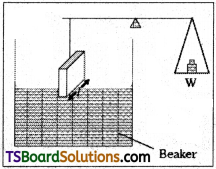
Procedure :
A cleaned glass plate is taken. Its length ‘l’ and thickness ‘t’ is measured. Since thickness ‘l’ is very small when compared with length t, thickness ‘t’ is ignored.
Glass plate is fixed to metallic rod. Necessary weights are placed in the pan and glass plate is made horizontal to the table. Weights in pan W0 is measured. Pure liquid whose surface tension is to be determined is taken in a glass beaker. The liquid is poured until it just touches the glass plate. Now plate is pulled down with some force due to surface tension of liquid. Weights in the pan are gradually increased until the glass plate is just escaped from forces of surface tension. Weights W1 are noted. The experiment is repeated for three to four times and average weight W1 is noted.
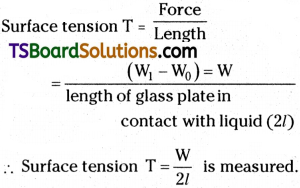
Long Answer Questions
Question 1.
State Bernoulli’s principle. From conservation of energy in a fluid flow through a tube, arrive at Bernoulli’s equation. Give an application of Bernoulli’s theorem.
Answer:
Bernoulli’s theorem :
Bernoulli’s theorem states that “when a non viscous liquid flows between two points then the sum of pressure energy, kinetic energy and potential energy per unit mass is always constant at any point in the path of that liquid”.
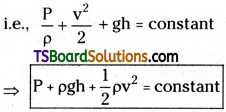
Bernoulli’s theorem is applicable to non viscous, incompressible and irrotational liquids in streamline flow only.
Proof :
Let us consider that a liquid of density ‘ρ’ is flowing through a pipe of different area of cross sections A1 and A2 as shown.
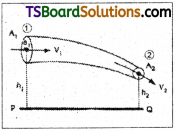
Let the liquid enters at A1 with a velocity V1 and with a pressure P1, density of liquid at A1 is say ρ. Let the liquid leaves the pipe through A2 with a velocity V2 and pressure P2. Density of liquid at A2 is say ρ.
Since liquid is incompressible, p is con-stant.
At region 1 the liquid will move a distance of V1 ∆t where ∆t is very small time interval. Similarly at region 2 the liquid will move through a distance V2 ∆t.
Work done on fluid at region 1 = W1 = P1 A1
V1 ∆t = P1∆V
Work done on fluid at region 2 = W2 = P2 A2 V2 ∆t = P2 ∆V
Since same volume of liquid pass through the pipe, ∆ is constant.
∴ Work done by fluid = W1 – W2 = (P1 – P2) ∆V → 1
∵ Liquid is uncompressible ‘ρ’ is constant.
So mass of liquid entering the pipe and leaving the pipe ∆m is given by
∆m = ρA1V1∆t = ρ∆V
Change in potential energy of liquid
∆U = ρg∆v(h2 – h1) → 2
Change in kinetic energy of liquid
∆K = \(\frac{1}{2}\)ρ∆v(V²1 – V²2)
From work energy theorem work done = change in energy
∴ ∆W = ∆U + ∆K
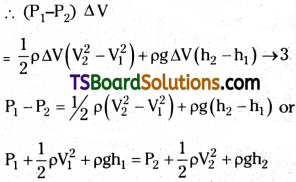
i.e., sum of pressure energy, potential energy and kinetic energy of the fluid is always constant.
Limitations :
Bernoulli ‘s theorem is applicable to non-viscous and uncompressible liquids only.
Applications of Bernoulli’s theorem :
- Dynamic lift on the wings of an aeroplane is due to Bernoulli’s theorem.
- Swinging of a spinning cricket ball is a consequence of Bernoulli’s theorem.
- During cyclones, the roof of thatched houses will fly away. This is a consequence of Bernoulli’s theorem.

Question 2.
Define coefficient of viscosity. Explain Stoke’s law and explain the conditions under which a rain drop attains terminal velocity, υt. Give the expression for υt.
Answer:
Coefficient of viscosity (η) :
The viscous force acting tangentially on unit area of the liquid when there is a unit velocity gradient in the direction perpendicular to the flow is defined as “Coefficient of viscosity.”
Coefficient of viscossity η = \(\frac{-F}{A}\frac{dx}{dv}\)
Unit Nm-2 – s (or) pascal – second.
According to Stoke’s law, the viscous force acting on a freely falling, smooth spherical body of radius ‘a’ is proportional to the coefficient of viscosity η, radius ‘a’ and velocity ‘υ’ of the body.
∴ F ∝ ηav or F = 6 π η av, where 6π is the proportionality constant.
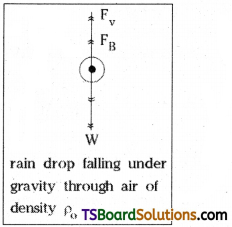
A rain drop of radius ‘ω’, density ρ falling under gravity through air of density a experiences a force of buoyancy equal to the weight of displaced air which is (\(\frac{1}{2}\)πa³) σg.
The weight of the rain drop acting downwards = (\(\frac{1}{2}\)πa³) ρg.
∴ Resultant force acting downwards = \(\frac{1}{2}\)πa³ρg – \(\frac{1}{2}\)πa³σg
When this force is equal to the viscous drag acting upwards, then the rain drop acquires a constant velocity called terminal velocity, vt.
At terminal velocity viscous drag = 6πηav.
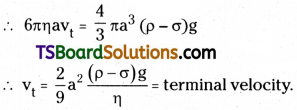
Definition:
Terminal velocity of a body falling through a liquid is defined as that constant velocity which the body acquires when it falls in a fluid.
Problems
Question 1.
Find the excess pressure inside a soap bubble of radius 5 mm. (Surface tension is 0.04 N/m). [TS May ’16]
Solution:
Radius r = 5 mm = 5 × 10-3 m.
Surface tension ST = 0.04 N/m
= 4 × 10-2 N/m.
Excess pressure inside soap bubble
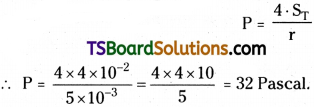
Question 2.
Calculate the work done in blowing a soap bubble of diameter 0.6 cm. against the surface tension force. (Surface tension of soap solution = 2.5 × 10-2 Nm-1)
Solution:
Work done = Surface tension (S) × increase of area (2 × 4πr²)
∴ W = S ( 4πr² ) × 2
(since the bubble has two surfaces)

Question 3.
How high does methyl alcohol rise in a glass tube of diameter 0.06 cm? (Surface tension of methyl alcohol = 0.023 Nm-1 and density = 0.8 gmcm-3. Assume that the angle of contact is zero)
Solution:
Surface tension of methyl alcohol (S) = 0.023 N/m.
Density, ρ = 0.8 gr/cm³ = 800 kg/m³
Diameter of tube, D = 0.06 cm
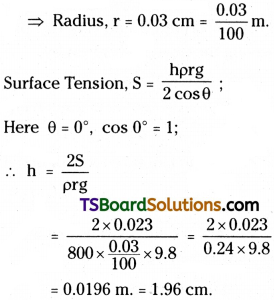

Question 4.
What should be the radius of a capillary tube if water has to rise to a height of 6 cm in it ? (Surface tension of water – 7.2 × 10-2 Nm-1)
Solution:
Surface Tension of water,
S = 7.2 × 10-2 N/m
Height of water, h = 6 cm = \(\frac{6}{100}\) m
Radius of capillary tube r = ?
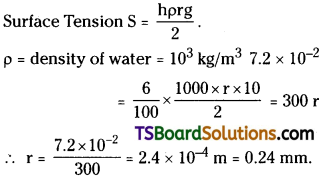
Question 5.
Find the depression of the meniscus in the capillary tube of diameter 0.4 mm dipped in a beaker containing mercury. (Density of mercury = 13.6 × 10³ Kg m-3 and surface tension of mercury = 0.49 Nm-1 and angle of contact = 135°).
Solution:
Diameter of tube = 0.4 mm ;
∴ Radius, r = 0.2 mm = \(\frac{0.2}{10^3}\) m
Density of mercury = 13.6 × 10³ kg/m³
Angle of contact, 0 = 135°
Surface tension of mercury, S = 0.49 N/m.
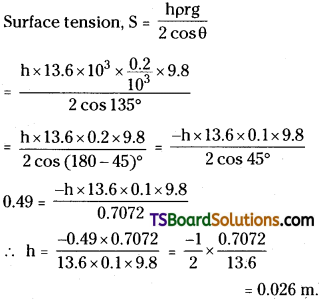
Question 6.
If the diameter of a soap bubble is 10 mm and its surface tension is 0.04 Nm-1, find the excess pressure inside the bubble. [TS Mar. ’18, My ’16; AP June ’15; Mar. ’14]
Answer:
Diameter of soap bubble =10 mm
Radius, r = 5 mm = 5 × 10-3m
Surface tension, S = 0.04 Nm-1
Excess pressure inside the soap bubble, P = \(\frac{4S}{r}\)

Question 7.
If work done by an agent to form a bubble of radius R is W, then how much energy is required to increase its radius to 2R?
Solution:
Energy required to form soap bubble of radius, R = W .
∴ w = 8πR²
Work done to blow a bubble of Radius 2R = 8π(2R)² = 4w
∴ Work done to increase the radius from R to 2R = 4w – w = 3w

Question 8.
If two soap bubbles of radii R1 and R2 (in vacuum) coalasce under isothermal conditions, what is the radius of the new bubble. Take T as the surface tension of soap solution.
Solution:
When joined in isothermal condition change in temperature of system is zero. So change in internal energy of the system is zero.
Let
Surface energy of 1st bubble U1 = 8πR2S
Surface energy of 2nd bubble U2 = 8πR²1S
Surface energy of new bubble U = 8πR²2S
But 8πR²S= 8πR²1S + 8πR²2S
⇒ R² = R²1 +R²2
Radius of new bubble R² = \(\sqrt{\mathrm{R}_1^2+\mathrm{R}_2^2}\)
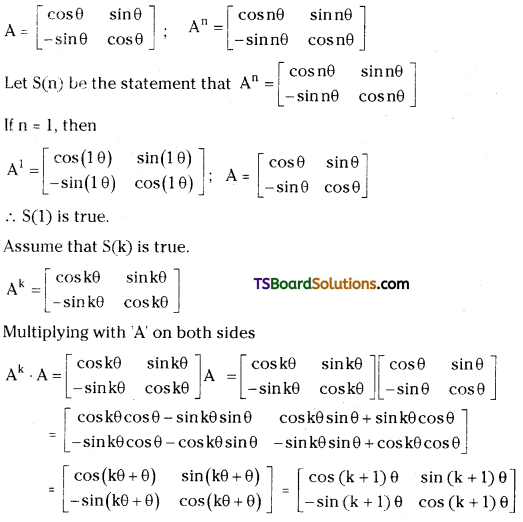
![]()
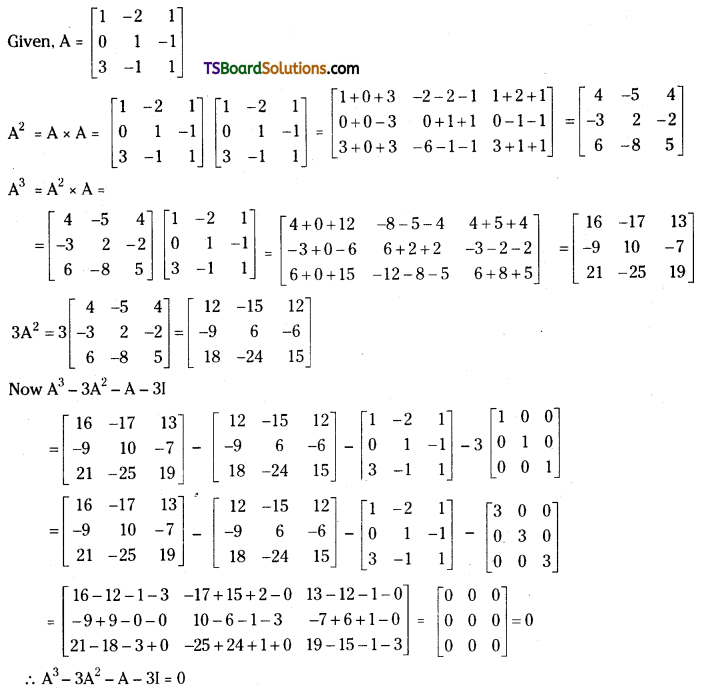
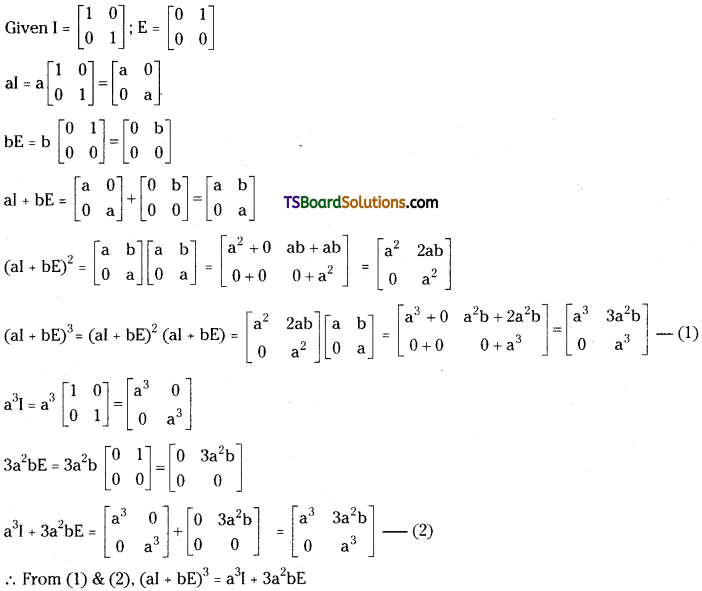
![]()
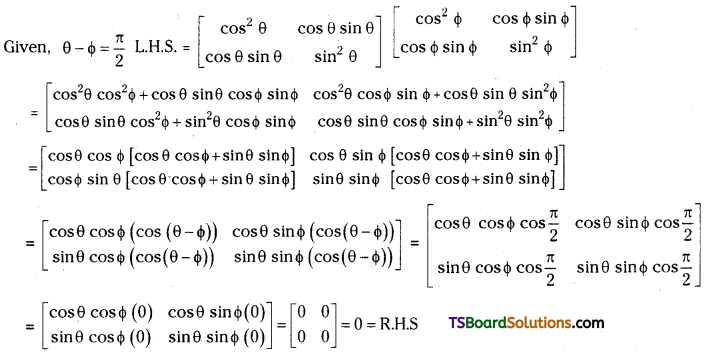
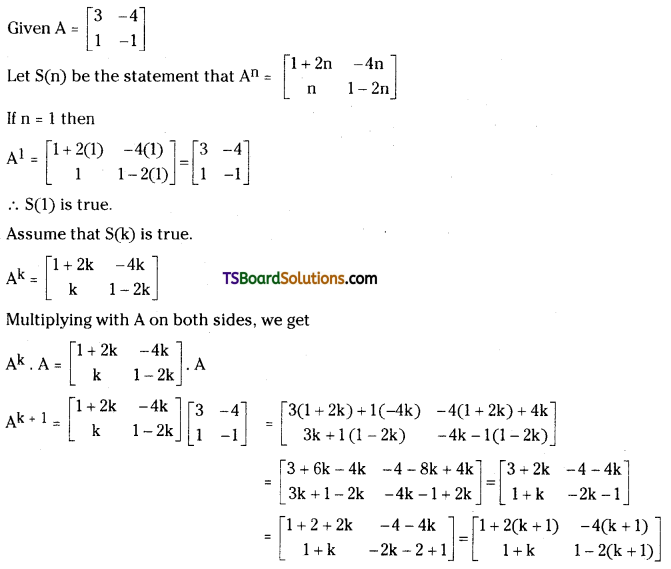
![]()
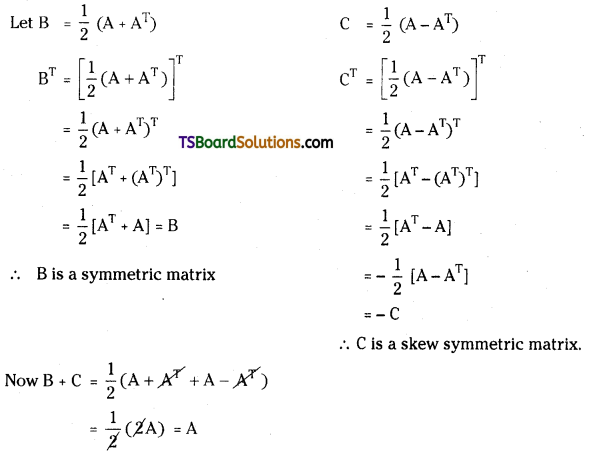
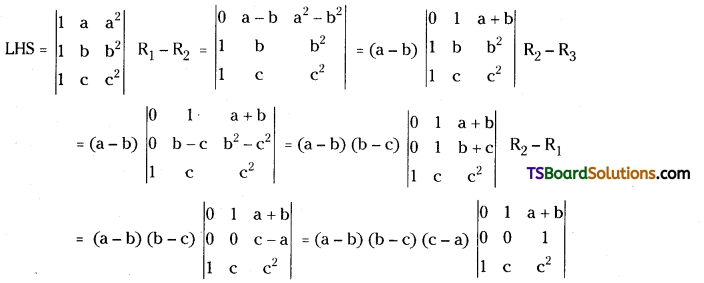

![]()
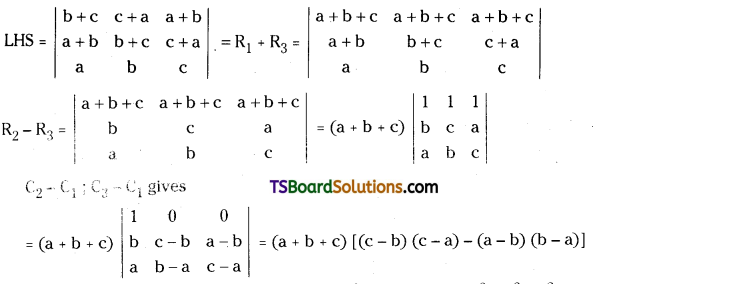
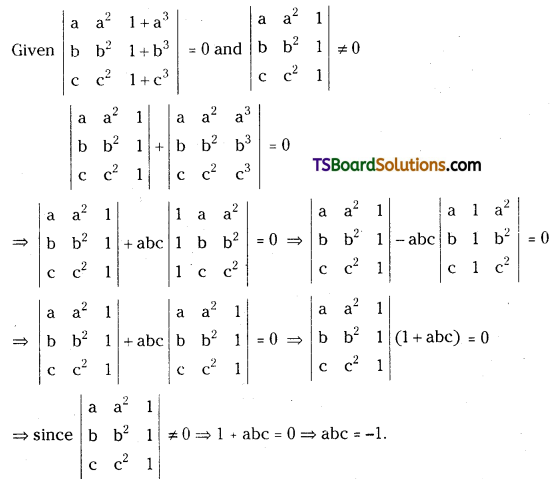
![]()
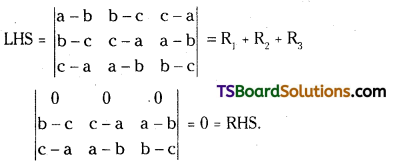
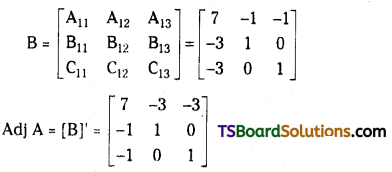

![]()
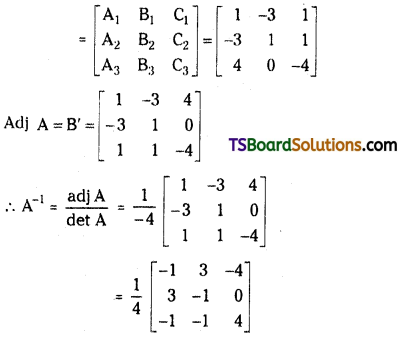

![]()
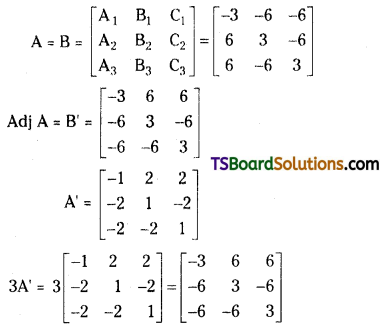
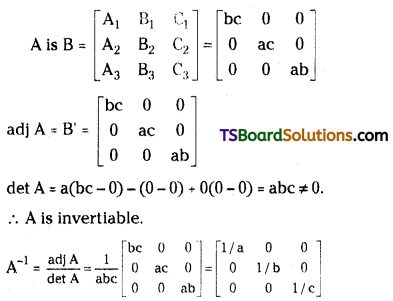
![]()
